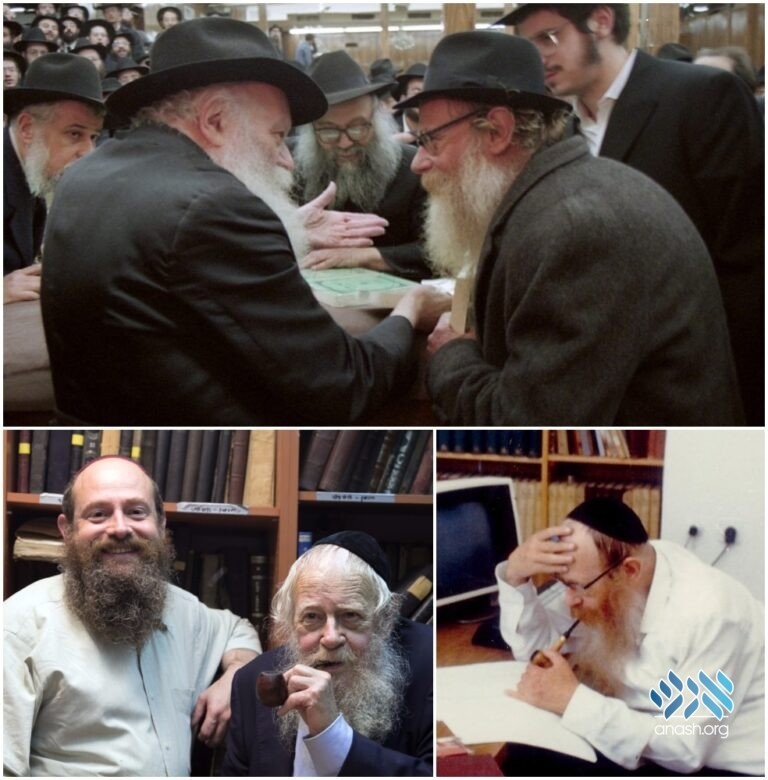Much has been written about Rabbi Adin Even-Israel (Steinsaltz)’s life and multifaceted scholarliness. In honor of Hey Teves, his son told Anash Magazine about another aspect of his life: His deep-seated connection to the Rebbe, and the Rebbe’s involvement in his works.
By Rabbi Meni Even-Israel
Executive Director of the Steinsaltz Center – Yerushalayim
Hey Teves, the “celebration of books,” goes hand in hand with the Rebbe‘s call for a house full of seforim. In many ways, the Rebbe’s nesius was surrounded by seforim – the creation of seforim, encouraging people to learn from them, and celebrating new publications.
In the year 1990, the Rebbe gave out what I call the ‘Green Tanya.’ There are many photos of individuals receiving this special edition. One of the most iconic images that we have in the Steinsaltz Center, is of the Rebbe talking with my father – Rabbi Adin Even-Israel (Steinsaltz) – while handing him the Tanya. This photo also graces the cover of my father’s book “My Rebbe.” It is fitting that this iconic image of my father with the Rebbe is associated with receiving the Tanya, which my father translated and explained in his seminal work on Chassidus.
Throughout his career of writing and publishing books, the Rebbe guided my father. He was in many ways like a partner to my father’s endeavors in writing and beyond. The Rebbe would often tell him, ‘I don’t like to interfere,’ and then tell him what he should do…
My father began his work on translating and typesetting the Gemara. We are talking about a time when typesetting was done physically by hand, using stamps made from clay or other materials, long before the advent of computers. It was an old-fashioned process, not quite 16th century, but certainly traditional. One major challenge was the tremendous amount of information on each page, including commentary, translation, images, and notes.
At that time, two options emerged for page layout. One was to expand the page throughout the process so that one page might take up three or four pages with commentary, of which we have a few samples. The Rebbe’s instructions were interesting; he suggested that each page should be divided in two. This approach led to the creation of the iconic big brown books. Although my father suffered criticism for this move, he believed the Rebbe was correct and followed his directives.
The second notable instance was when the Rebbe requested my father to create ‘Sefer HaKen,’ which was to be published for the Alter Rebbe’s 150th yurtzeit. He gave specific instructions about what he wanted in the book and insisted on not being part of it, asking my father to collaborate with then President of Israel, Zalman Shazar. This project was delayed for various reasons, leading to the Rebbe inquiring about its progress. This book eventually was released in a first edition in 1969. We had the zchus to republish the Sefer Haken in honor of my oldest son’s bar mitzvah.
The third instance involved the three small books ‘Women in the Talmud,’ ‘Men in the Talmud,’ and ‘Biblical Images.’ Two peculiar things about the Rebbe’s response to these: firstly, his address to my father changed from Harav Hachassid (‘the Chassidic Rabbi’) to Harav Hagaon (‘the great Rabbi’). Secondly, he commented on one of the cover images, which depicted the Luchos as round instead of square.
The fourth time the Rebbe “interfered” was when my father had the idea to create a new commentary on the Tanya, making it more accessible. The Rebbe’s response was quite stern, insisting that the words of the Tanya must remain intact and that any commentary should not alter the original text.
The fifth and last time the Rebbe commented on my father’s work was after a challenging period with certain groups who set out to damage his reputation. My father was disheartened, but the Rebbe encouraged him with the saying, ‘לפום צערא אגרא’ – according to the pain is the reward.
The idea of Torah study in Chabad has always been taken seriously. No other Rebbe published as much as our Rebbe, and the impact on our learning is tremendous. The continuous demand for learning was embedded in all of us. He instilled in us the need for continuous learning, not just in theory or the spiritual realm, but in actual, constant study, whether it be Sichos, Maamorim or daily study. The Rebbe insisted on creating a movement in which owning a library of Jewish books and studying them are paramount to Jewish life.
This article first appeared in Anash Magazine – published by Anash.org.

Discussion
In keeping in line with the Rabbonim's policies for websites, we do not allow comments. However, our Rabbonim have approved of including input on articles of substance (Torah, history, memories etc.)
We appreciate your feedback. If you have any additional information to contribute to this article, it will be added below.